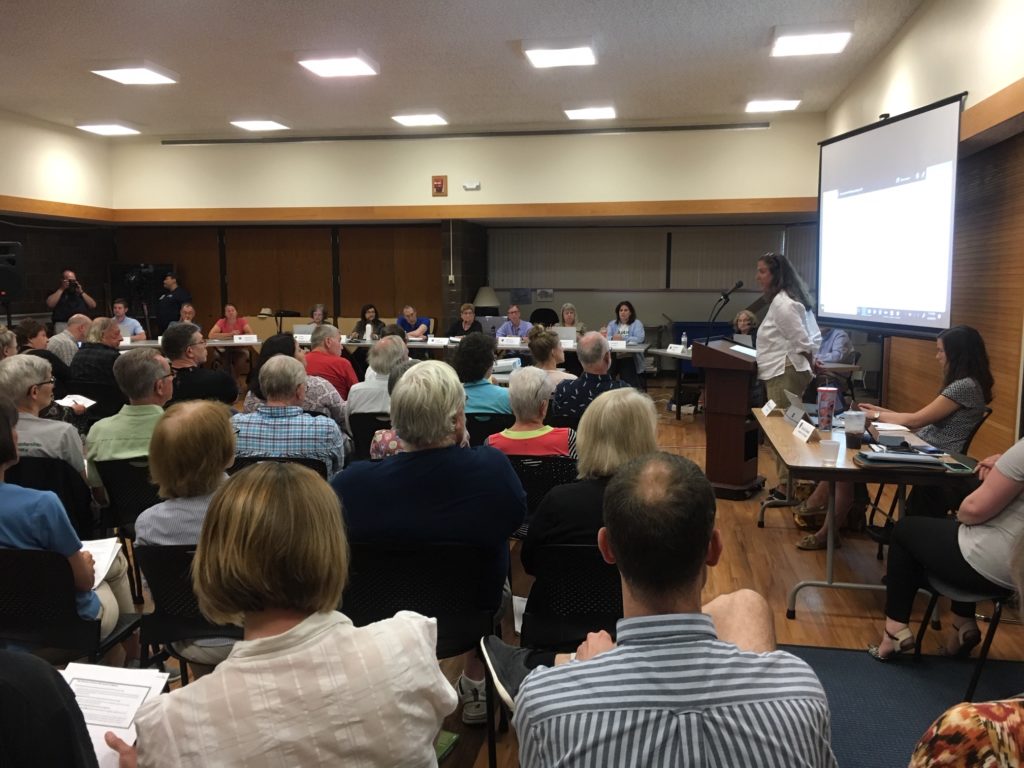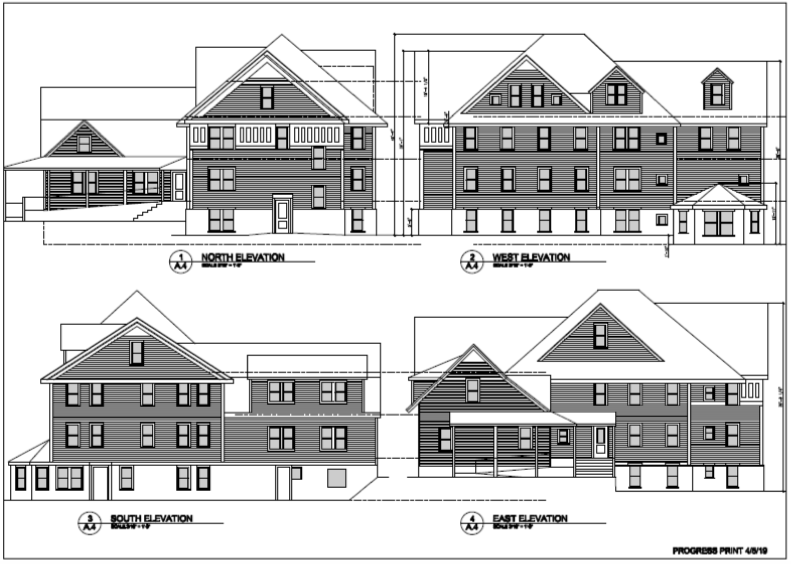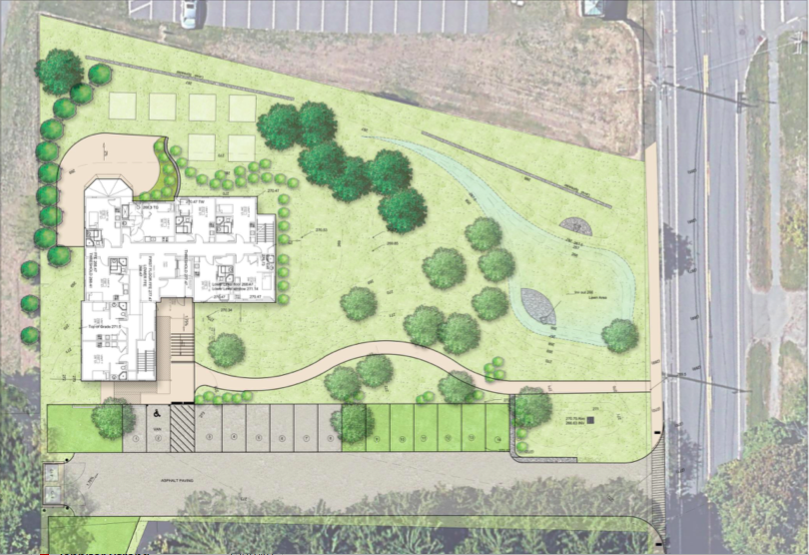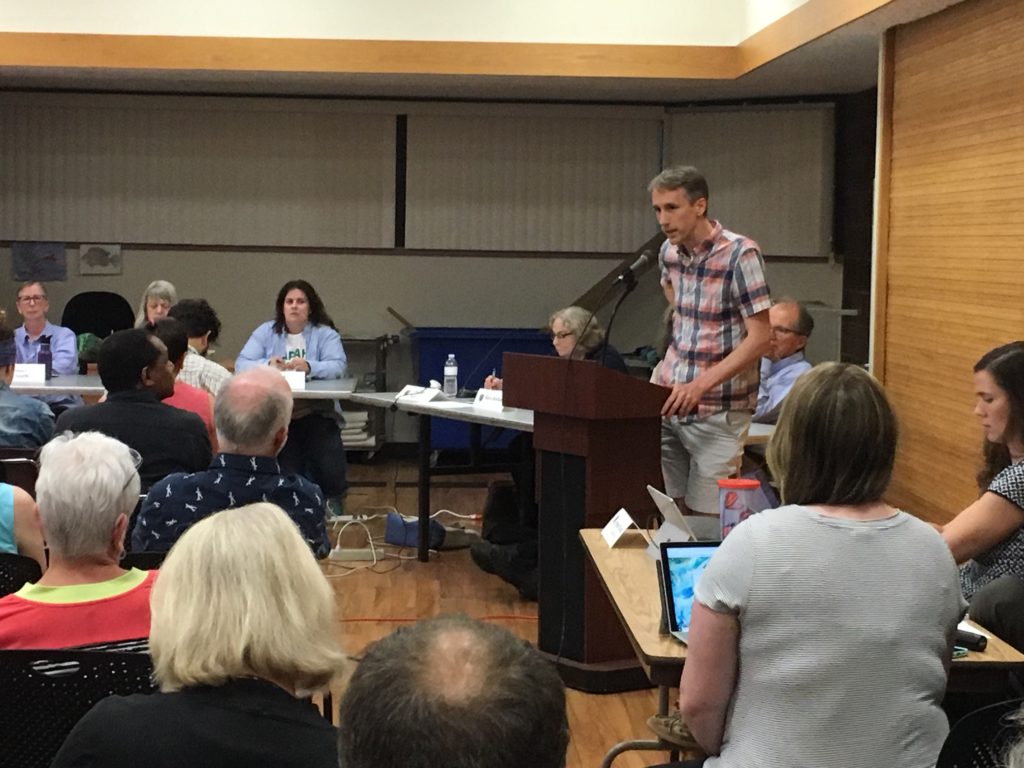PUBLIC FORUM ON NORTHAMPTON ROAD PROJECT

Pamela, a resident of the Bridge Street Valley CDC residence in Northampton, shared her experiences of community during a public hearing on the proposed Northampton Road affordable housing project. Photo: Art Keene
The Community Preservation Act Committee’s recommendation for the affordable studio apartment project at 132 Northampton Road was spotlighted in a Town Council public forum on June 24, 2019 in the Bangs Center. The event drew an overflow crowd of more than 100 people with about 30 people relegated to standing.
Following a review of protocols by council President Lynn Greisemer the meeting was divided into four sections. First, advocates for the project were given 30 minutes to present the plan under consideration. Then neighbors and abutters who oppose the project were given about 45 minutes to express objections and concerns.
Then, following a short break, Town Planner Christine Brestrup reviewed the timeline and permitting processes that would be implemented if the council approves borrowing for the project. The floor was then opened for public comment and over the next hour and a half many people offered comments, questions, testimonials, and data. Amherst Media taped the meeting and the video and the town has posted letters sent to the council concerning the project (48 in support and 18 opposed as of this writing). These are all accessable on the town website. What follows is a brief summary of the presentations at the forum.
In Support of the Project
The meeting began with Nate Budington, chairman of Amherst’s Community Preservation Act Committee, explaining that his diverse committee (in terms of age, occupations, and neighborhoods represented) supported this project unanimously and more enthusiastically than any of the other projects approved by the committee this year. He said the committee felt that this was a good proposal at a good location, with a good organization to spearhead it and that it would meet a vital town need. He stated that the folks who would seek housing in a project like this are already in our community.
Then, Laura Baker of Valley CDC presented the rationale for the project, its location, tenant mix, unit size, and income limits. Eight units are reserved for those making 80% of average mean income (AMI) ($49,790/year), eight for those making 60% of AMI ($31000/year), ten for recently homeless individuals (earning up to $18,600/year) and two for Department of Mental Health clients. Two units would be handicapped accessible. She showed the proposed design, which would incorporate the existing house on the lot, and the site plan. The proposed building is three stories with a sloped roof that could allow 2 units on the fourth floor. There will be an elevator. She also reviewed the police and fire calls for the four similar buildings that Valley CDC has managee in Northampton for the past three years, which show a slightly higher rate of calls over other neighborhoods, (1.55 police calls per resident as opposed to 1.06 calls for the town as a whole and 2.11 9-1-1 calls per resident as opposed to 1.58 from the Amherst Motel and 3.35 for the Arbors). However, there were no incidents of violence, theft, or damage to the surrounding buildings or people. Baker noted that many of these calls were associated with Valley CDC residents as victims, not perpetrators.

Liz Reino from Human Management Resources (HMR), the management company used by Valley CDC for the previous 3 years, spoke about the screening of potential residents to the facility. HMR manages housing for 8000 families and individuals on the east coast. Potential residents for the proposed housing would be referred by local social service providers. Candidates undergo a credit and criminal record check. HMR coordinates with local agencies and helps future tenants navigate available services. HMR meets regularly with Valley CDC and service providers.
Pamela, a resident of the Bridge Street Valley CDC residence in Northampton spoke of the community created among the residents. Even though the building is currently being renovated and she is currently living in a larger apartment, the Bridge Street residents get together regularly and Pamela is planning on moving back to her studio apartment when it is completed.

In Opposition to the Project
Steve George contended that the project did not conform with the existing neighborhood noting that even though most of the housing across the street are rentals, and that the corridor contains some dormitories, the homes between Route 9 and Amity St. are largely single family homes. George argued that new projects should be consistent with the existing character of the neighborhood.
Kate Sims suggested that the town buy the land and develop it differently. She suggested that five units for families would be preferable. She also said she thought the cost of the project (approximately $4 million) was too high.
Rosie Cowell, a neuroscientist at UMASS, brought charts showing excess police and fire calls to Valley CDC projects in Northampton. Her data were compiled from 1997- to the present. She argued that the proposed project needed a 24/7 manager on-site to insure both resident and neighborhood safety. This would add $150,000 a year to the operating cost. The desire for full time on-site management was emphasized by many of the opponents during the public comment section.
The Approval Process
Christine Brestrup, Planning Director, presented the expected timeline for the project. If the Council authorizes the $500,000 bond on July 1, Valley CDC will go to various funding agencies in the state to raise the remaining $3.5 million. If the project receives funding, the Zoning Board of Appeals will need to approve it in detail. She notes that this will be another opportunity for residents to voice their concerns. Letters will be sent to all abutters, along with the detailed plans. The ZBA review usually takes 3 to 6 months. Construction could begin sometime in 2020 for occupancy in 2021.
Following the formal presentations Valley CDC took questions from the Councilors. Among questions asked were how many residents will live or work in Amherst (estimated at least 70 per cent of occupants) and what would happen if not enough applicants were in the higher income brackets of 50% and 80% AMI (they would keep looking for those who could pay the higher rents).
Public Comment
Public comment was extensive, with the majority of speakers supporting the project and emphasizing the great need for affordable housing in Amherst. Testimony was offered by experts in community development, affordable housing, housing law human services and homelessness as well as by people living in the vicinity of the proposed project. . Testimony was offered by people who were formerly homeless and by at least one person who identified as currently homeless. Some people spoke of their personal relationships with people who live, or have lived in, projects similar to the one proposed. David Alfield and Michael Giles were two of five residents from the neighborhood who spoke in favor of the project.

Photo: Art Keene
Neighborhood residents in opposition spoke of their general support for affordable housing but objected to this project for multiple reasons – including its perceived poor fit with the neighborhood and concerns about a possible increase in crime or bad behavior. Some also criticized the project as being too expensive, of being poorly designed, or being an injudicious use of tax dollars. Several neighbors complained about not being informed about Valley CDC’s plans, being brought into the conversation late in the process, and about the town being unwilling to engage in negotiation with the neighbors about the scope of the project. Some also expressed worry that Amherst College might rescind their community access to Pratt Field if there were untoward incidents involving the residents of this building. Nicola Usher proposed that if this was indeed a risk, it could be minimized by bringing together existing residents, the new residents, and Amherst College to build a welcoming community.
Opponents also voiced concerns about the suitability of the location to meet the needs of its residents because of the distance to a bus stop, groceries, and stores. They raised concerns about the comorbidities that these people might come with, including mental health and addiction histories. Gerry Weiss of the Craig’s Doors board stated that the residents would be carefully screened and would be “house ready” i.e., prepared to live independently. Ginny Hamilton, former director of the Fair Housing Coalition in Boston, reminded the council that discrimination in housing on the basis of race, age, gender and mental health issues is illegal in Massachusetts.
Multiple speakers pointed out that many town employees, including teachers, fire fighters, and clerical workers in the schools and town hall cannot afford to live in Amherst and that many would qualify for this kind of housing under the salary caps.
All speakers were allowed 3 minutes to speak, some multiple times. Only one person was cut off by Council President Lynn Griesemer when the speaker attempted to refer disparagingly to the concerns about losing access to Pratt Field as elitist.
The council will decide whether to authorize the $500,000 bond for the project at its July 1 meeting. Because it involves borrowing, at least 9 counselors (i.e., two-thirds) must approve the bond.
Additional Links:
Town of Amherst Site for the Project at 132 Northampton Road:
Video of Finance Committee Meeting Where Vote on Project was Taken:
